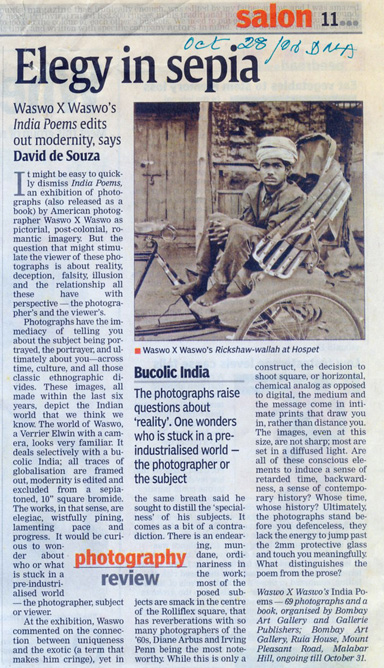The Photograph : Painted, Posed and of the moment, an exhibition currently on at the NGMA is perhaps the most significant piece of photography to manifest itself all in one place. The exhibition is wonderfully curated with not a single image being out of place or superfluous. In that sense if you want to ‘trip’ as in a Pablo Barthomew, come prepared with comfortable shoes and at least 3 hours to spare. You cannot or should not rush through this show. In many ways, the exhibition on at the NGMA will be a harbinger of things to come, all bode well for photography and the arts.
The photographs are arranged in a very finite order at every ‘etage’ of the gallery. On the ground floor as you enter, you will be messmerised by images that have messmerised us for many years now, that have in some ways etched themselves into the collective unconscious. All the photographs on this floor have been seen before, but when you stand in front of an original Henri Cartier Bresson bromide, its like meeting an old friend, an aristocrat, and a god. Everything that can be said about Bresson has been said so it would be completely dangerous to tread this territory, however there are magnificent texts by artists, sociologists, historians, musicians, editors, photographers, writers and theatre personalities among others who give the viewer another insight via language where at times the silence of the still image could speak more eloquently.
Kobo Abe in one of those placards says that a Bresson image – is not a window into space rather into Time. That sentiment could be parsed differently, most of Bresson’s images exceed the Einsteinian restrictions of space/time, they move into a zone of timelessness, The geography and specificity of that Title – Mexico 1934 become redundant. Ferdinando Scianca speaks of another image of a veiled woman with child – Mexico 1934, he celebrates the ‘lack of sentimentality or the picturesque’ in that image and is spared of the ‘blackmail of rhetoric’. He says pithily, that the image was ‘taken in Mexico but devoid of mexicanisation’. This might well be a lesson to all those photographers who trump the ethnic. Andre Pieyne writes about what he calls the ‘love spiders’ the image of two lesbian women revealing tastefully just enough without being salacious. The issue of photographer as voyeur does crop up repeatedly, Eduardo Arroyo notes that the humorous photograph of two men in Brussels 1932, ‘one peeping through a hole at reality that is concealed from us and the other in a bowler hat looking around suspiciously at being observed’, reminds us that we, the per-viewer of the camera’s view are all in the picture. The notion of photograph as premonition is revealed by Leonardo Sciasia with the famous image Sevilla, Spain 1933, the children depicted seem to be ‘playing with war, a war they do not yet know’.
Interestingly Bresson gave up photography for 15 years till his death, his decisive finger was sketching instead. No doubt Bresson would be one of the most vivisected photographers that ever lived, his work will be scanned for psychological, social, anthropological and aesthetic nuances, its best to sum him up with one sentence, Cartier Bresson is not a photographer, he is a Photography(sic)
Pablo Batholomew who we knew and loved from the junior world press days and with sporadic visual interventions, was perhaps significant by his absence. You got the feeling that he was lost and unable to find a new way of telling old stories. The second floor digs through his archive and in all those years of sex drugs and rock and roll reveal what he found worthy of imaging, this is a sort of confession, laying open his private diary. There are some matter of fact photos of a lavatory 1975, bed sheets, Carmen’s house, Bathroom shelf and a college dining room that speak of honesty and non pretentiousness that invade most of our modern ways of seeing. The fungus on his self portrait negatives are in some ways as telling. The Jawa motorcycle and the rounded cornered Allwyn refrigerator are visual semiotics of an era.
Dayanita Singh’s Sent a Letter moves away from the arrogance of the limited edition archival print to a more engaging, human, quiet, understated, accordion series of books that you can posses when you leave the gallery, these are small jewels of private communication, all the images are in a square format and contact size. there is an intimacy, beauty and stillness to them. She shares space with Nony Singh her mother whose need to archive the family is beautifully depicted. The portraits are exquisite.
On the fourth floor is Umrao Singh Sher- Gil whos many self portraits and gorgeous little sepia contact prints speak of His Misery, His Manuscripts and narcissism. The autochrome back-lit images of family are stunningly beautiful.
The only other colour photographs ironically are the ones that predate colour photography, they belong to the Alkazi collection, there are the familiar colonial Deen Dayal type images but more interesting are the hand tinted photos which a decade later sometimes, gave the original, black and white photographs, a new context and added a layer of the aesthetic of a different decade. The exhibit is under lit not surprisingly, the pigments and dyes would be prone to fading. There are astonishing images that could be an inspiration to a whole generation of contemporary photographers and artists alike, but the jewel in the crown is a hand coloured Daguerrotype, you register a double take and in its mirrored image across two hundred years you can get a glimpse of yourself.
